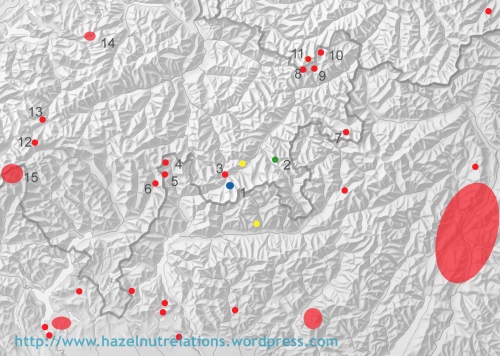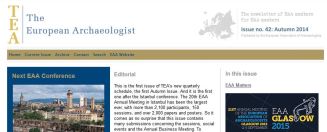Every year on the second Friday of March about 150 Swiss prehistorians gather in Bern. This year they were made to look at, amongst other things, the red dots on the map be below. I made this map for a presentation Th. Reitmaier and I gave at the yearly meeting of Swiss Prehistorical Society (AGUS). Since the 1980s quite a few Mesolithic sites have been found in the central Alps of northern Italy. Until the beginning of the 21st C hardly any Mesolithic sites were known in the Swiss Central Alps, however. There is Mesocco Tec Nev, of course. And many sites are known further west in the Cantons of Fribourg, Vaud and Wallis. Since ca. 2000 the map of Canton Graubünden in southeastern Switzerland has slowly been filling up as well. As in the Italian Central Alps, many off the sites are found above 1800masl and many date to the 8th and early 7th mill BC.
We presented the site of Bergaglia, Val Forno-Plan Canin. Amateur archaeologist K. von Salis discovered a few chipped stone tools and charcoal in the steep sides of a hiking trail going up to the Fornoglacier and the Murettopass. The trail already had cut through it and threatens to erode it further. To establish the nature of the archaeology and its state of preservation we placed two test-trenches over the two find spots, which were ca. 8m apart. In each of the two test trenches a multi-phased hearth was found, dating to the late 8th and early 7th Mill. BC. A further find probably dates to the early fifth Mill BC. While earlier Mesolithic (Sauveterrien and Castelnovien) finds are common, not many sites dating to the latest Mesolithic and especially the earliest Neolithic are known in the sub-alpine and alpine zones of the central Alps. A further hearth dates to the Late Bronze Age.

All known Mesolithic sites in this part of Switzerland and most sites/site concentrations in Italy. (yellow: two Bronze Age sites.)
1. Bergalia, Val Forno-Plan Canin; 2. Pontresina, Val Languard-Chamanna dal Paster; 3. Maloja, Lunghinpass; 4. Val S. Giamcomo-Borghetto; 5. Val S. Giacomo-Pian dei Cavalli; 6. Mesocco Tec Nev; 7. Mustair-Lai da Rims; 8. Guarda, Val Tuoi, Abri Frey; 9. Ftan, Val Urschai, Plan da Mattun L2 & L3; 10. Sent, Fimba, Kuppe Blaisch; 11. Galtür, Jamtal, Abri Futschöl; 12. Airolo-Alpe di Rodont; 13. Hospental Moos; 14. Muotatal Caves; 15. Sites of the Simplon-region.
The Alps are of course a stunning natural landscape. However, we should not forget it has been heavily shaped by human activity during the past ten thousand years. And this process continues to this day. The impact of our activity in the Alps, whether in the shape of tourism, mining, transport and the changing agricultural practices should not be underestimated. This means we, archaeologists as well as policy makers, should be aware of the threats our living in and enjoyment of the Alps pose to our cultural heritage. These same activities, however, provide many opportunities to discover hitherto unknown archaeology. The word-cloud lists the most prominent categories of threats to archaeology in the alpine regions. (I wrote more about this here and here.)

concept & production by Th. Reitmaier
However, it is not only through this more `passive´ way of discovery that we can increase our knowledge of the cultural history of the Alps. It has been shown that active searching for archaeological remains, through survey work with well aimed research questions and adequate methodology, can be very successful. These surveys can vary between simple field-walking to predictive modelling (put into practise here) and everything in between.
One cannot protect what one does not know. Cantonal Units can therefore not limit themselves to dig known sites that are in danger of being destroyed, but should increase their knowledge of the archaeology in their Canton and actively search for it, whether in the Alps or in the lowlands.
If you are ever in the Alps and find any archaeological finds in the sides of a hiking path, on a ice patch on a pass or anywhere else, please get in touch with the local police or the people in the nearest mountain hut or hotel and they will pass on the information to the archaeological authorities. We need your help and are very interested in hearing from you!
The test-trenching at Bregalia, Val Forno, Plan Canin will be published in the Jahrbuch Archäologie Schweiz 2012:
Cornelissen, M., Reitmaier, Th., Gubler, R., Andres, B. & Hess, Th., 2012, Bregaglia, Val Forno, Plan Canin – Eine neue alpine Fundstelle im Oberengadin, in Jahrbuch Archäologie Schweiz, Vol. 95, pp.133-140
 Glacial archaeologists from Switzerland and Italy met last May in Berne and the meeting resulted in quite a bit of media interest. The meeting was innitiated by the L’Académie suisse des sciences humaines et sociales (ASSH/SAGW) and they have set up a website with with a number of ressources concerning the meeting and glacial and ice-patch archaeology. Do have a look, esp. also at the glacial archaeology dossier in their Bulletin (2/2019)! And certainly not just because I was also fortunate to be allowed to contribute something about the so far little known “Fuorcla da Strem Sut”-site, the oldest glacial archaeological site from the Alps, dating back to the Mesolithic.
Glacial archaeologists from Switzerland and Italy met last May in Berne and the meeting resulted in quite a bit of media interest. The meeting was innitiated by the L’Académie suisse des sciences humaines et sociales (ASSH/SAGW) and they have set up a website with with a number of ressources concerning the meeting and glacial and ice-patch archaeology. Do have a look, esp. also at the glacial archaeology dossier in their Bulletin (2/2019)! And certainly not just because I was also fortunate to be allowed to contribute something about the so far little known “Fuorcla da Strem Sut”-site, the oldest glacial archaeological site from the Alps, dating back to the Mesolithic. 

























